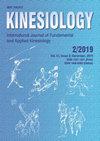Is there any difference in fitness profiles among the Croatian basketball players?
IF 0.9
4区 医学
Q4 REHABILITATION
引用次数: 1
Abstract
The aim of the study was to establish possible differences in both aerobic and anaerobic fitness parameters among different positions (point guards, guards and small forwards, and power forwards and centers) in basketball. Based on previous research on certain differences among play positions in basketball, aerobic and anaerobic fitness capacity values of basketballers in different positions were analyzed. Seventy adult basketball players (age 24.37±4.05 years) from the Croatian Division 1 league were classified as point guards (n=20), shooting guards and small forwards (n=26), and power forwards and centers (n=24). Six variables of cardiopulmonary function were obtained using spirometry and spiroergometry test. Regarding aerobic abilities, a significant difference among the three positions was found only in the VO2max parameters (p=.00) in favor of power forwards and centers (5.55± 0.6 l/min) when compared to point guards (4.7± 0.6 l/min) and shooting guards and small forwards (5.01±0.6 l/min). No significant difference was found in the Croatian basketballers’ anaerobic capacity parameters among the three different play positions.克罗地亚篮球运动员的健康状况有什么不同吗?
该研究的目的是确定不同位置(控球后卫、后卫和小前锋以及大前锋和中锋)在有氧和无氧健身参数方面的可能差异。在前人研究篮球运动中不同体位之间存在一定差异的基础上,分析了不同体位篮球运动员的有氧和无氧健身能力值。来自克罗地亚甲级联赛的70名成年篮球运动员(年龄24.37±4.05岁)被分为控球后卫(n=20)、得分后卫和小前锋(n=26)以及大前锋和中锋(n=24)。用肺活量测定法和呼吸量测定法获得心肺功能的六个变量。关于有氧能力,与控球后卫(4.7±0.6升/分钟)、得分后卫和小前锋(5.01±0.6升每分钟)相比,三个位置之间只有大前锋和中锋的VO2最大参数(p=0.00)有显著差异(5.55±0.6升/分钟)。克罗地亚篮球运动员的无氧能力参数在三个不同的比赛位置之间没有显著差异。
本文章由计算机程序翻译,如有差异,请以英文原文为准。
求助全文
约1分钟内获得全文
求助全文
来源期刊

Kinesiology
REHABILITATION-SPORT SCIENCES
CiteScore
1.90
自引率
8.30%
发文量
16
审稿时长
>12 weeks
期刊介绍:
Kinesiology – International Journal of Fundamental and Applied Kinesiology (print ISSN 1331- 1441, online ISSN 1848-638X) publishes twice a year scientific papers and other written material from kinesiology (a scientific discipline which investigates art and science of human movement; in the meaning and scope close to the idiom “sport sciences”) and other adjacent human sciences focused on sport and exercise, primarily from anthropology (biological and cultural alike), medicine, sociology, psychology, natural sciences and mathematics applied to sport in its broadest sense, history, and others. Contributions of high scientific interest, including also results of theoretical analyses and their practical application in physical education, sport, physical recreation and kinesitherapy, are accepted for publication. The following sections define the scope of the journal: Sport and sports activities, Physical education, Recreation/leisure, Kinesiological anthropology, Training methods, Biology of sport and exercise, Sports medicine and physiology of sport, Biomechanics, History of sport and Book reviews with news.
 求助内容:
求助内容: 应助结果提醒方式:
应助结果提醒方式:


